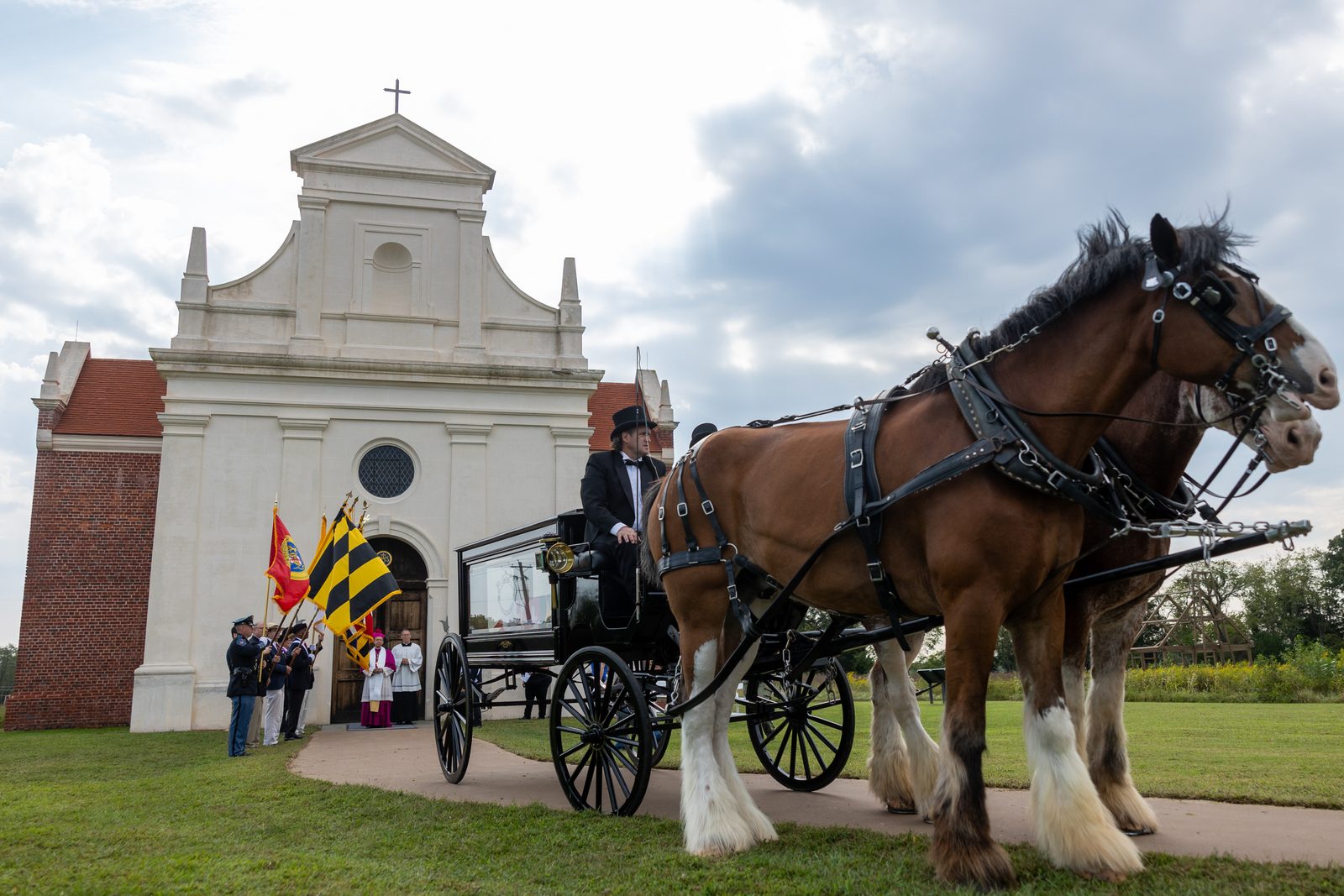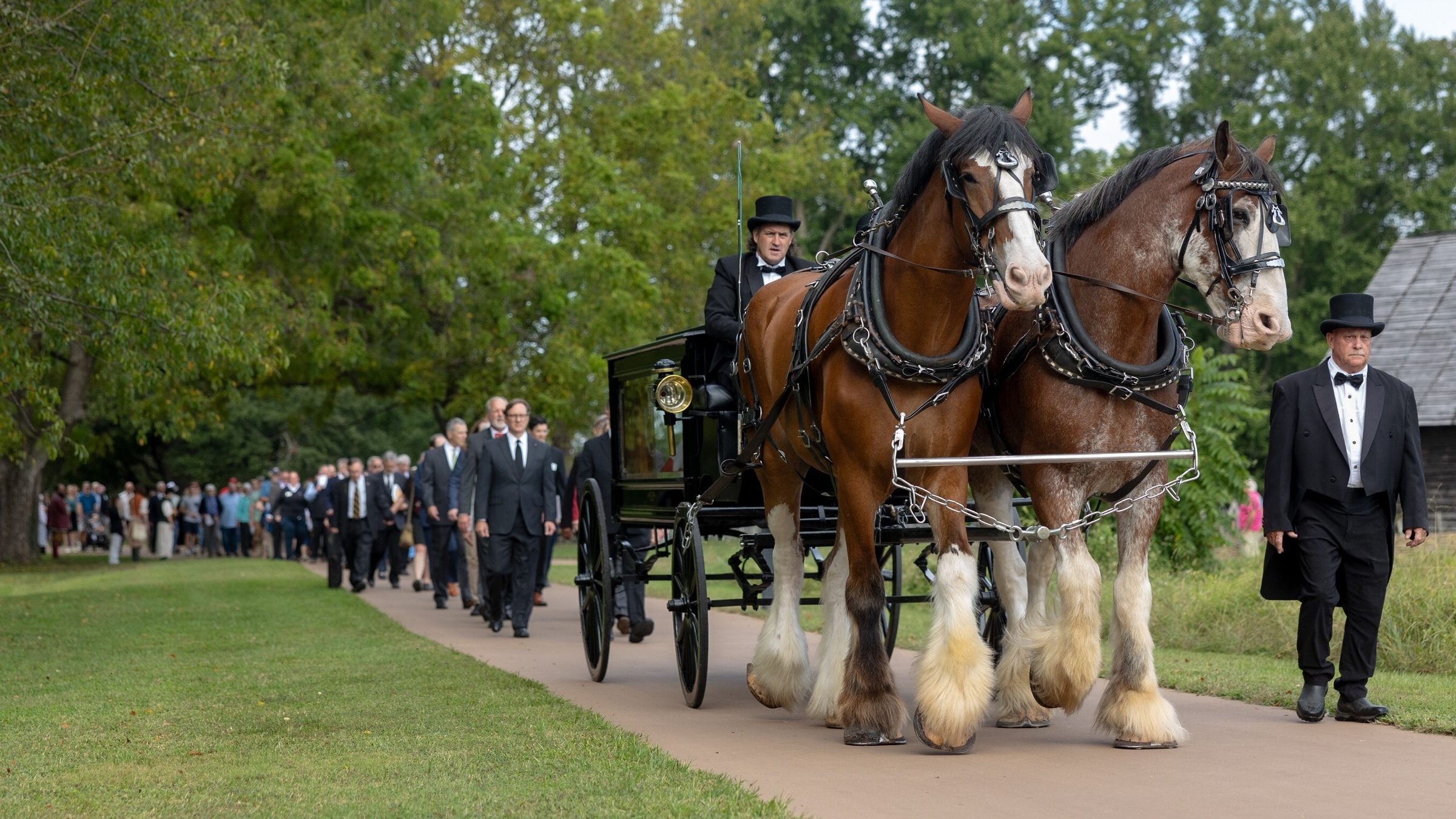Two majestic Clydesdale horses pulled the hearse bearing a pine coffin with the remains of eight young children from colonial-era Maryland in a procession on Sept. 20, 2025 that stretched about one-half mile from the reconstructed State House of 1676 in Historic St. Mary’s City to the rebuilt 1667 Brick Chapel, where Baltimore Archbishop William E. Lori presided at a reinterment rite.
They were being brought home to the site where the skeletal remains of 65 early Marylanders had been carefully removed in the 1990s around the foundation of the original brick chapel – believed to be the first permanent Catholic church building in the English colonies – so the remains would not be damaged in the historic chapel’s reconstruction.
In a personal way, the procession stretched from Maryland in the 1600s to Maryland in 2025, as many of the participants had family roots in the colony which was a birthplace of religious freedom in what became the United States – including eight honorary pallbearers carrying the coffin who were descendants of 17th century Marylanders.
As the pallbearers solemnly carried the coffin from the reconstructed State House, Noah Posey, a sophomore at La Plata High School, played a rope drum and wore a round woollen Monmouth cap, a vest and linen breeches, short trousers worn in that era with long stockings.

He was accompanied by his father, Jason Posey, who also wore dress from that period, including a metal helmet and breastplate. The father and son, who are members of St. Ignatius Parish in Chapel Point, are descendants of Francis Posey, who arrived in Maryland around 1640.
Jason Posey noted their ancestor had been an orphan in London who first arrived in Virginia as an indentured servant, and he later became an assemblyman in the Maryland colony. “I’m sure he walked these grounds,” said Jason Posey.
He expressed admiration for the perseverance of those early colonists, who took a risk leaving their homes in England and made a new life in Maryland. “We wouldn’t be here without them,” he said.
The early Maryland colonists survived harrowing boat rides across the Atlantic Ocean and then many did not live long as they endured various hardships including hunger and disease and adjusting to life and making a living off the land in a new climate.
Lord Baltimore, a Catholic, established Maryland as a haven for liberty of conscience and religious toleration. The first Marylanders included people from many different branches of Christianity who lived and worked side-by-side. The reconstructed Brick Chapel stands as a landmark of faith and symbolizes Maryland’s status as a birthplace of religious freedom in the United States.
“As a Catholic, it (that legacy) has a lot of spiritual meaning,” Posey said.

One of the pallbearers, Peter Pearre – a retired architect who is a descendant of Cecil Calvert, the second Lord Baltimore who championed religious tolerance in the Maryland colony – reflected on what participating in the reinterment ceremony meant to him.
“It’s an incredible honor, and it’s also very humbling to think there are these children who died so long ago and never were able to experience a full life like we take for granted,” he said.
During the rite, Pearre carried a container with the remains of Philip Calvert’s infant son who had been buried in a small lead coffin at the chapel site. Excavations in the foundation there uncovered lead coffins with the remains of Philip Calvert, an early governor and chancellor of Maryland, his wife Anne Wolseley Calvert and an infant son. Philip Calvert was Cecil Calvert’s half-brother.
Pearre expressed admiration for what his ancestor, Cecil Calvert, accomplished. “He inherited from his father, George Calvert, the responsibility of establishing Maryland. He deserves a lot of credit. He was able to pull it off and protect it during turbulent times,” Pearre said.
He noted how Cecil Calvert established Maryland as a place where Catholics and other Christians could practice their faiths and not be beholden to a state religion, as was the case in England. “It (Maryland) was an open place where you could worship as you please,” he said.
Another honorary pallbearer, Kelsey Bush, is a descendant of Eleanor “Irish Nell” Butler, an Irish woman who was an indentured servant, and Charles Butler, an enslaved African man. They were married around 1681 in a Catholic wedding in Charles County, Maryland, and because she married an enslaved man, she and their children were also enslaved.
“It’s a wonderful love story,” Bush said, adding, “She gave up her freedom to marry the man she loved.”
Bush – who works as a community affairs liaison for St. Mary’s County – said participating in the reinterment ceremony was a “full circle” moment for him. As a student at St. Mary’s College in St. Mary’s City more than three decades earlier, he had assisted in the efforts to remove coffins from around the foundation of the original chapel before the reconstructed Brick Chapel was built at the site.
Also serving as an honorary pallbearer for the reinterment ceremony was Jamie Mattingly, who works as a school bus contractor. His ancestor, Thomas Mattingly, worked as a farmer in Maryland in the mid-1600s. DNA studies done on the remains of the early Marylanders removed from the chapel site suggest that Thomas Mattingly may be among the adults who was reinterred there.
Asked what he admired about his ancestor, Mattingly said, “He was obviously a strong believer in God, a Catholic, with a strong work ethic and strong family ties and beliefs.”
Mattingly, who is a parishioner at Our Lady’s Church at Medley’s Neck in Leonardtown, said the early Marylanders “were incredible people who endured great hardships and persevered through so much.”
Asked what today’s residents of Maryland could learn from those forebears, he said, “The value of faith and the value of hard work and persistence.”

Another honorary pallbearer that day was Jeffrey Scott Watkins, a descendant of Robert Clark, who came to the Maryland colony as an indentured servant in 1637 and later served as Lord Baltimore’s surveyor general and was a representative in the upper house of Maryland’s colonial government.
Watkins, a member of Sacred Heart Church in Glyndon, Maryland, said in an email that the reinterment ceremony offered a memorial to the faith of the early Marylanders and highlighted Maryland’s legacy in safeguarding “the right to worship in the style and tradition of one’s conscience,” which he said helped inspire the right of freedom of religion established in the First Amendment of the U.S. Constitution.
Among the guests attending the reinterment ceremony was Carolyn Wands DeToye, who is a direct descendant of George Calvert and his son Leonard Calvert. She traveled about 900 miles to Southern Maryland all the way from Danville, Illinois, where she serves as a city council alderman.
“It means everything to me,” she said of participating in the ceremony.
Reflecting on her Calvert ancestors, DeToye said, “I’m very proud of them, extremely proud they pushed freedom of religion.” To honor her family heritage, she makes an annual pilgrimage to Kiplin Hall in Yorkshire, England, the home of George Calvert.

Two of the other honorary pallbearers – sisters DeAnna Poling and Debora Hansen – are ancestors of the first couple to be married in the new Maryland colony, Mistress Anne Cox, a noblewoman, and Thomas Greene, who became an early governor of Maryland. Anne Cox and Thomas Greene apparently met while traveling with other passengers on the Ark and Dove, the ships that sailed to Maryland in 1634, and they were married in a Christian ceremony shortly after landing in the new colony.
“We would love to have dinner with Anne Cox,” DeAnna Poling said, laughing. She added they would like to know what prompted her to get on a ship with predominantly men and only a few women. About 140 people were estimated to have made that first voyage from England to Maryland, and the Society of the Ark and the Dove lists Anne Cox and two other women among the known passengers.
Anne Cox’s adventure is something she discusses and ponders with her daughters. “What would compel you to leave from the Isle of Wight in 1633 and think that’s a good idea at 21 years old to voyage into the unknown?” she asked.
Her sister Debora Hansen agreed, saying, “I have three daughters and a granddaughter, and we talk about what courage it took to venture into the unknown.”
The sisters’ own discovery of their family roots has been an adventure, too. Both women are natives of Montana. Hansen went on to work for the Delaware Department of Education, and Poling worked as a banker in the Seattle area. Now they are retired and living in Delaware. After their grandmother in Montana died, they had her rollback desk shipped to Delaware, and they discovered that their grandmother had researched the family genealogy, and that information stored in the desk revealed their notable early Maryland ancestors.

For honorary pallbearer Carlton Hoskins, the reinterment ceremony offered a time to honor the legacy of his ancestor and to pass on that lesson to his children. Hoskins, a member of St. Mary’s Parish in Annapolis who works as a national security advisor at Fort Meade in Maryland, brought his son, Carlton Hoskins Jr., who is 13; and his daughter, Catherine Calvert Hoskins, who is 8; along with him to witness the ceremony.
His ancestor, Richard Nevitt, was 15 years old and a servant when he was among the first Maryland colonists to disembark from the Ark and the Dove in 1634.
Hoskins said he discussed with his children “what those people went through to come here for religious freedom and also for a new life. Once they arrived, they still had to fight for that freedom.” He added, “It’s amazing to think what it took for those people to board that ship and leave their life behind, and then to arrive here and settle in a new land.”

Reflecting on the legacy of those early Marylanders, Hoskins said, “There’s a lot we face today. We should take strength in their faith.”
Explaining why it was important for him to bring his son and daughter to the ceremony, Hoskins said, “I’m trying to pass that on (to them), to know who you are and where you come from, gives you perspective on your life.”
Related story:
Some of Maryland's first colonists come home, as their remains brought back for reinterment ceremony at Brick Chapel in Historic St. Mary's City
https://www.cathstan.org/local...
Link to photo gallery:











